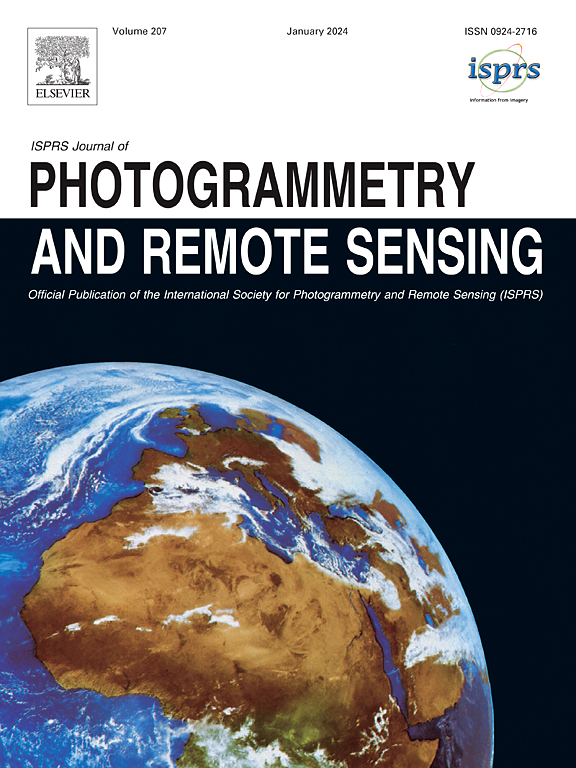多视InSAR数据解包裹误差与衰落信号校正
IF 12.2
1区 地球科学
Q1 GEOGRAPHY, PHYSICAL
ISPRS Journal of Photogrammetry and Remote Sensing
Pub Date : 2025-02-01
DOI:10.1016/j.isprsjprs.2024.12.006
引用次数: 0
摘要
在大规模InSAR数据处理中,以减少数据量和提高信噪比为目的的多视处理是必不可少的。然而,多重观察导致的“衰落信号”破坏了三重态干涉图之间的相位一致性,并在估计位移时引入了偏差。这种不一致挑战了三元组阶段闭包中只涉及展开错误的假设。因此,解缠结相位解包裹误差和三重态相位闭合产生的衰落信号对于实现更精确的InSAR测量至关重要。为了解决这一挑战,我们提出了一种新的方法来减轻相位解包裹误差和衰落信号。这种新方法包括两个关键步骤。第一步是基于三重态相位闭合的叠加,它允许在每个干涉图中直接估计衰落信号。第二步是基于基追求去噪的解包裹纠错,将解包裹纠错转化为稀疏信号恢复。通过这两个步骤,新方法可以无缝集成到传统的InSAR工作流程中。此外,估计的衰落信号可以直接用于导出土壤湿度作为我们的方法的副产品。在旧金山湾区的实验结果表明,新方法将速度估计误差降低了约9% - 19%,有效地解决了相位解包裹误差和衰落信号。这种性能优于ILP和Lasso方法,后者只处理三元组闭包中的展开错误。此外,衍生的副产物土壤湿度与大多数外部土壤湿度产品具有很强的一致性。本文章由计算机程序翻译,如有差异,请以英文原文为准。
Unwrapping error and fading signal correction on multi-looked InSAR data
Multi-looking, aimed at reducing data size and improving the signal-to-noise ratio, is indispensable for large-scale InSAR data processing. However, the resulting “Fading Signal” caused by multi-looking breaks the phase consistency among triplet interferograms and introduces bias into the estimated displacements. This inconsistency challenges the assumption that only unwrapping errors are involved in triplet phase closure. Therefore, untangling phase unwrapping errors and fading signals from triplet phase closure is critical to achieving more precise InSAR measurements. To address this challenge, we propose a new method that mitigates phase unwrapping errors and fading signals. This new method consists of two key steps. The first step is triplet phase closure-based stacking, which allows for the direct estimation of fading signals in each interferogram. The second step is Basis Pursuit Denoising-based unwrapping error correction, which transforms unwrapping error correction into sparse signal recovery. Through these two procedures, the new method can be seamlessly integrated into the traditional InSAR workflow. Additionally, the estimated fading signal can be directly used to derive soil moisture as a by-product of our method. Experimental results on the San Francisco Bay area demonstrate that the new method reduces velocity estimation errors by approximately 9 %–19 %, effectively addressing phase unwrapping errors and fading signals. This performance outperforms both ILP and Lasso methods, which only account for unwrapping errors in the triplet closure. Additionally, the derived by-product, soil moisture, shows strong consistency with most external soil moisture products.
求助全文
通过发布文献求助,成功后即可免费获取论文全文。
去求助
来源期刊

ISPRS Journal of Photogrammetry and Remote Sensing
工程技术-成像科学与照相技术
CiteScore
21.00
自引率
6.30%
发文量
273
审稿时长
40 days
期刊介绍:
The ISPRS Journal of Photogrammetry and Remote Sensing (P&RS) serves as the official journal of the International Society for Photogrammetry and Remote Sensing (ISPRS). It acts as a platform for scientists and professionals worldwide who are involved in various disciplines that utilize photogrammetry, remote sensing, spatial information systems, computer vision, and related fields. The journal aims to facilitate communication and dissemination of advancements in these disciplines, while also acting as a comprehensive source of reference and archive.
P&RS endeavors to publish high-quality, peer-reviewed research papers that are preferably original and have not been published before. These papers can cover scientific/research, technological development, or application/practical aspects. Additionally, the journal welcomes papers that are based on presentations from ISPRS meetings, as long as they are considered significant contributions to the aforementioned fields.
In particular, P&RS encourages the submission of papers that are of broad scientific interest, showcase innovative applications (especially in emerging fields), have an interdisciplinary focus, discuss topics that have received limited attention in P&RS or related journals, or explore new directions in scientific or professional realms. It is preferred that theoretical papers include practical applications, while papers focusing on systems and applications should include a theoretical background.
 求助内容:
求助内容: 应助结果提醒方式:
应助结果提醒方式:


